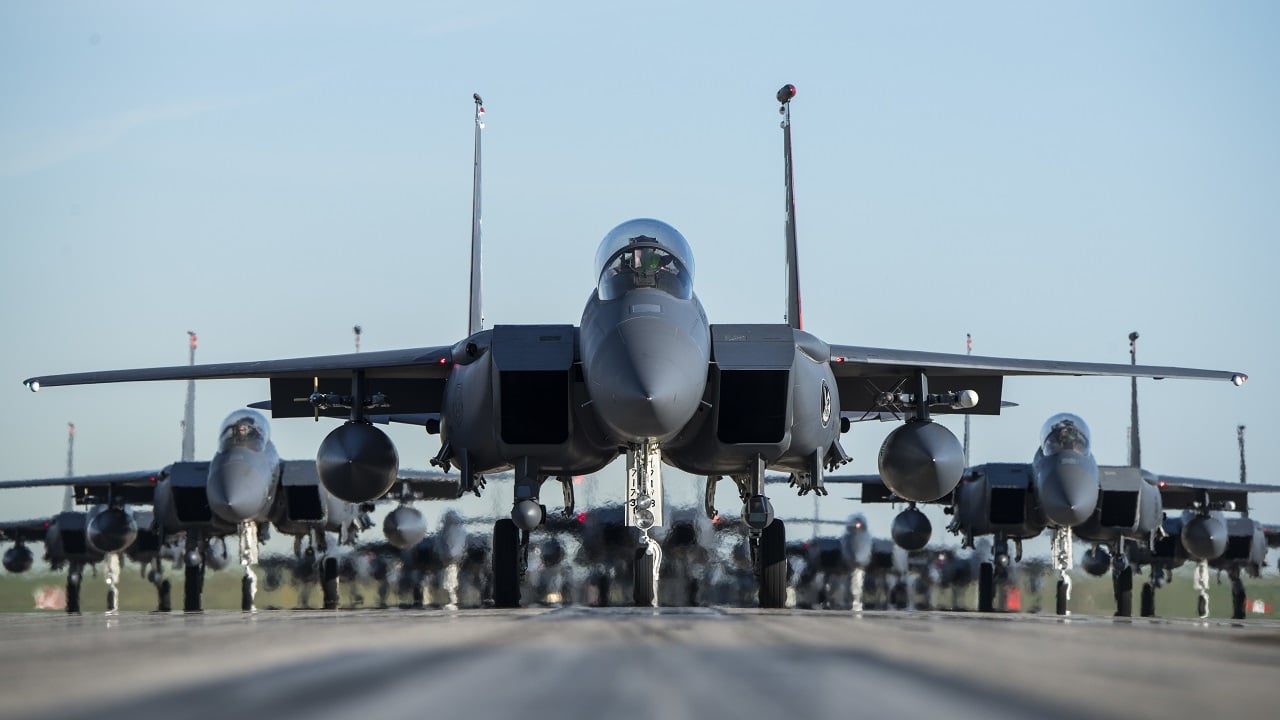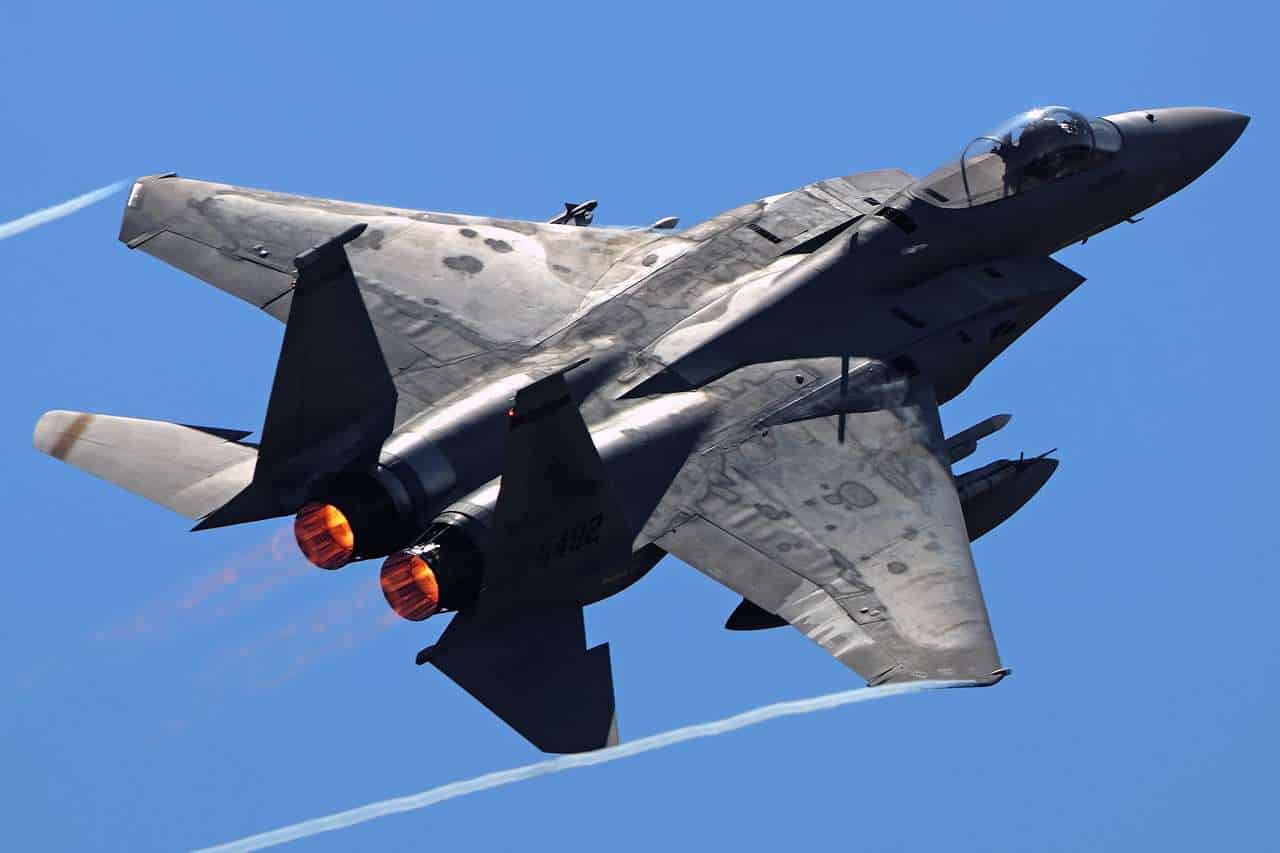F-15 Fighter Jet Images - Three F-15E Strike Eagle fighter jets follow the moon's shadow around the Earth during the solar eclipse.
The planes that took off from southern Idaho stayed in the shadow of the moon for three minutes. The speed of the Moon, and the speed of the Earth's rotation, means that aircraft must be very close to stay within the darkness created by the Moon.
F-15 Fighter Jet Images

During a solar eclipse, large parts of the planet experience partial or total darkness for a few minutes as the Moon passes in front of the sun. During a solar eclipse, the sun turns into night because the Moon blocks the sunlight. The moon itself shines dimly because of the scattered and broken light that shines on it.
When Three F 15 Jet Fighters Raced A Solar Eclipse
As this National Geographic video shows, three F-15 Strike Eagles based at Mountain Home Air Force Base, Idaho, tried to capture the moon as long as they could. Problem: the shadow of the moon rotates at 1700 kilometers per hour, but the earth rotates at 1000 kilometers per hour. The goal is to stay under the shadow of the moon for three minutes.
The F-15E Strike Eagle is one of the fastest aircraft on the American market. The "Mud Hen" version of the F-15C Eagle can fly at a speed of Mach 2.5, or 1,918 miles per hour. That raw speed is enough to accomplish the moon mission.
The Air Force isn't the only service interested in the moon: In August 2017, the Navy sent two EA-18G Growler electronic attack aircraft to search for another moon. Civilian lunar observers also book special flights to observe them a bit more than people on the ground, without clouds blocking their view. They may not have seen it until these F-15E jets did, however.
Secret Hypersonic Air Force Now Builds Weapons For Terrorists, Treasure Hunters And More Prince Harry Sends Fighter Jet Once After His Father Picks Canada's F-35 As First Plane.
Why Israel's F 15 Fighter Jet Is One Of The Most Feared Planes In The Sky
What Is Life In An Airplane Hangar Why Does The US Have A Stealth B-2 Bomber Popular Technology Machines For The US Space Force What Machines Does The Space Force Use? From Popular Technologies to US Space Force Goals and Missions
Army Seeks V-280 for Next-Generation Attack Transport Why the F-105 Thunderchief is Such a Badass Aircraft Air Force Launches New B-21 Raider Bomber 5 US Bombers Spot in Adriatic Sea Derived from McDonnell Douglas F-15 Eagle. The F-15E was designed in the 1980s for long-range missions, without relying on escort or electronic fighter jets. United States Air Force (USAF) F-15E Strike Eagles are often distinguished from other US Eagle variants by the black aircraft camouflage, conformal fuel tanks (CFT) mounted on the engine loading ramps (although CFTs can also be pre-installed on F-15 variations) and a tandem seat.
Strike Eagle has been deployed for military operations in Iraq, Afghanistan, Syria and Libya and others. In these operations, warplanes carried out deep attacks against high-altitude targets and air patrols of the war, and provided close air support to allied forces. It has been exported to many countries.

The McDonnell Douglas F-15 Eagle was produced by the USAF to replace its McDonnell Douglas F-4 Phantom II fleet. Unlike the F-4, the F-15 was designed for the air superiority mission with little thought for the ground attack role; The F-15 Special Project Office opposes the idea of making the F-15 an interceptor mission, saying "There is not a single kilogram of air-to-ground capability."
Indonesia To Buy Rafale Fighter Jets, As Us Approves F 15 Plan
In service, the F-15 has been a successful fighter, achieving more than 100 air combat victories and zero losses in air-to-air combat since 2007.
Despite the lack of official interest, McDonnell Douglas has been quietly working on an F-15 interceptor fighter. The company's aircraft will replace the existing F-111 and F-4, as well as supplement the existing F-15.
In 1978, the USAF began the All Weather Performance Study, which looked at the McDonnell Douglas proposal and other options such as buying more F-111Fs. The study recommended the F-15E as the USAF's future strike platform.
In 1979, McDonnell Douglas and Hughes began a close collaboration on the development of the F-15E's aerial capabilities.
Comparison Of F 15 Eagle And F 16 Fighting Falcon
To aid in the development of the F-15E, McDonnell Douglas modified a second TF-15A model, serial number AF 71-0291, as a demonstrator. The aircraft, known as the Advanced Fighter Demonstrator, first flew on July 8, 1980.
It has already been used to test conformal fuel tanks (CFT), originally designed for the F-15 under the name "FAST Pack", with FAST standing for "Fuel and Ssor, Imo". .
It is then fitted with a Pave Tack laser targeting pod to allow for the random delivery of guided bombs.

In March 1981, the USAF announced the Advanced Tactical Fighter program to provide a replacement for the F-111. The program was later renamed the Dual-Role Fighter (DRF). The concept creates an aircraft capable of conducting deep air missions without the need for additional support from a fighter or interceptor aircraft.
Cobi Boeing F 15 Eagle Tactical Fighter Jet
General Dynamics offered the F-16XL, while McDonnell Douglas offered the F-15E. The Panavia Tornado is also a contender, but it is not considered seriously because the aircraft does not have reliable air superiority combat power, in addition to the fact that it is not American.
The DRF evaluation team, under the leadership of Brigadier General Ronald W. Yates, lasted from 1981 to 30 April 1983, during which time the F-15E logged more than 200 flights, weighed more than 75,000 pounds (34 t), and had 16 configurations. location of weapons.
McDonnell Douglas, to help evaluate 71-0291, added it to another F-15 program, designated 78-0468, 80-0055, and 81-0063. The single-engine F-16XL is a promising design, with improved performance with a variable-delta wing; if selected, the single- and twin-engine versions should be the F-16E and F-16F, respectively.
On 24 February 1984, the USAF selected the F-15E; Important factors in the decision were the lower development costs of the F-15E compared to the F-16XL ($270 million vs. $470 million), the belief that the F-15E was the key to future development, and the availability of the twin gene booster.
F 15 Eagle > Air Force > Fact Sheet Display
Production of the first three F-15Es began in July 1985. The first of these, 86-0183, made its first flight on 11 December 1986.
Piloted by Gary Jennings, the aircraft reached a maximum speed of Mach 0.9 and an altitude of 40,000 feet (12,000 m) during the 75-minute flight.
This aircraft had all of the F-15E's avionics and a redesigned front fuselage, but lacked the common rear fuselage and engine bay.

The latter was shown in 86-0184, while 86-0185 contains all the F-15E changes from the F-15.
A Stealthy F 15 'silent Eagle' Fighter Jet Could Be A Terror In The Sky
The first production F-15E was delivered in April 1988 to the 405th Tactical Training Wing, Luke Air Force Base, Arizona.
The F-15E was upgraded with the Raytheon APG-82 Active Electronically Scanned Array (AESA) radar after 2007, and the first test radar was delivered to Boeing in 2010.
It combines the APG-79 processor used on the F/A-18E/F Super Hornet with the APG-63(V)3 AESA antenna installed on the F-15C;
Which also includes broadband radomes (possibly operating on more radar frequencies) and vironmt control and electronic warfare advances.
Just How Stealthy Is The U.s. Air Force's New F 15?
The F-15E has a strong air power capability twice that of previous versions, the F-15E is expected to remain in service through 2025.
, USF's F-15E fleet has an average age of 21 years and an average flight time of 6,000 hours. In 2012, the USAF was reportedly considering future options; No replacement has been identified for the F-15E. By 2021, Boeing said its F-15EX Eagle II aircraft will replace the USAF's F-15C Eagle fighter fleet, with the option to begin replacing the F-15E Strike Eagle as well.
The F-15EX Eagle II closely follows the design of the Strike Eagle, with a two-seat configuration as well as air-to-ground capabilities. The USAF has said it will look at the F-15EX in place of the Strike Eagles at a later date.
Another option is the F-35 Lightning II, which replaces other aircraft such as the F-16 Falcon; an F-35E variant was studied. Adding a second seat to the F-35 is complicated and expensive, especially to maintain the stealth profile; Providing a bigger route and loads will also be difficult tasks. Alternatively, the role could be filled by a combination of fighter and bomber aircraft, such as the B-21 Raider. The F-15E can also be replaced with a clean sixth generation aircraft design.
Air Force's New F 15ex Is Called 'eagle Ii'
On March 24, 2014, Boeing received a $30.6 million contract from DARPA as part of the Advanced Space Launch Authorization (ALASA) program. The goal of the program is to reduce the cost of putting microsatellites into orbit by 66 percent through improved launch systems. Under the 11-month contract, Boeing will build twelve 24 ft (7.3 m) launch vehicles, each with a payload capacity of up to 100 lb (45 kg). An ALASA vehicle is to be deployed under the F-15E, which will climb to 40,000 ft, then release its four engines and burn to reach low Earth orbit. Awarding the contract to Boeing will use the F-15E as a transport vehicle, as has been awarded in previous design contracts.
Second degree assault washington state, 2nd degree assault sentence, 2nd degree aggravated assault, 2nd degree assault mn, 2nd degree assault, 2nd degree assault definition, 3rd degree assault washington state, 4th degree assault washington state, 2nd degree felony assault, 4th degree assault washington, what is assault 2nd degree, 2nd degree assault charges